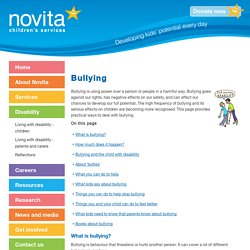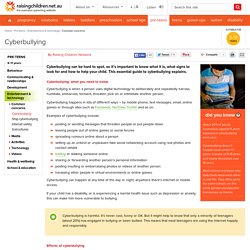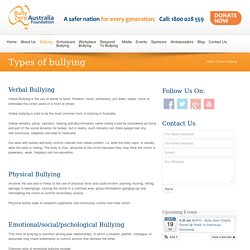

Novita Children’s Services - Bullying. Bullying is using power over a person or people in a harmful way.

Bullying goes against our rights, has negative effects on our safety, and can affect our chances to develop our full potential. The high frequency of bullying and its serious effects on children are becoming more recognised. This page provides practical ways to deal with bullying. On this page What is bullying? Bullying is behaviour that threatens or hurts another person. Teasingstaringname callingthreateningblocking the path of a personhitting or hurtingstealingspreading rumours—Definition of rumour Statement about someone that may not be true. Top of page contents How much does it happen?
Bullying probably happens in every school and even every classroom some of the time. That means if your child is in a class of 20 or more children, there are probably at least two or three kids in your child’s class who are bullied. Cyberbullying: kids and teens. Cyberbullying can be hard to spot, so it’s important to know what it is, what signs to look for and how to help your child.

This essential guide to cyberbullying explains. Cyberbullying: what you need to know Cyberbullying is when a person uses digital technology to deliberately and repeatedly harrass, humiliate, embarrass, torment, threaten, pick on or intimidate another person. Examples of cyberbullying include: Cyberbullying can happen at any time of the day or night, anywhere there’s internet or mobile access. If your child has a disability, or is experiencing a mental health issue such as depression or anxiety, this can make him more vulnerable to bullying. Cyberbullying is harmful. Effects of cyberbullying Children and teenagers who experience cyberbullying can end up being bullied at school. Children and teenagers might feel alone, lonely and isolated. Some victims of cyberbullying feel they have no safe place.
Helping your child avoid cyberbullying. Facts and figures about bullying. Bullying is happening everywhere and the chances that your child, or you, will encounter it are high.

Around the world, statistics are being collated on the impact and prevalence of bullying, particularly within schools and online in cyber space. With all schools talking about bullying and the media regularly reporting on latest research, it could seem like we're in a bullying epidemic. But, it's not all bad - the incidence of bullying, particularly the traditional face-to-face style, according to expert Dr Toni Noble, is not increasing. "It's a controversial area but with the effective communication of the message that bullying is unacceptable, it's just now more likely to be reported," says Dr Noble, a member of the National Centre Against Bullying, who works with the Federal Government on National Safe Schools Framework being rolled out into all schools later this year. Bullying Statistics in Australia. It is a sad fact that bullying, particularly in schools, is prevalent throughout the world, with Australia being no exception.

It seems to be a part of human nature to try and dominate others in a group, and these lessons that are learned in school tend to stay with children more than the official education they receive. Despite what a minority of people believe, any form of bullying can cause emotional problems, both at that time and later in life.
Not only do the victims suffer, but some of the bullies do too. It is not simply ‘a part of growing up’, but something that needs to be stopped. Bully Zero Australia Foundation. Verbal Bullying Verbal Bullying is the use of words to taunt, threaten, insult, embarrass, put down, swear, mock or intimidate the victim alone or in front of others.

Verbal bullying is said to be the most common form of bullying in Australia. Verbal remarks, jokes, sarcasm, teasing and discriminatory name calling could be considered as funny and part of the social dynamic for bullies, but in reality, such remarks can make people feel shy, self-conscious, hopeless and lead to insecurity. Our work with bullies and bully victims indicate that verbal content, i.e. what the bully says; is usually what the bully is feeling.
The bully is thus, attracted to the victim because they may think the victim is powerless, weak, helpless and non-assertive. Physical Bullying Physical bullies seek to establish superiority and continuous control over their victim. Emotional/social/pschological Bullying. Bullying.